Eco-Alianza Hosts International Summit for Centro de Estudios del Medio Ambient – CEMA
–– a US-Mexico Institutional Collaboration
It starts with an idea and a dream. A dream of a research field station in Loreto, BCS, born of international partnerships and alliances, a hub bustling with the activities of researchers, students, professors, journalists, and scientists from across the globe. A dream of an educational center to support exploration of the physiological treasures in the region, create a baseline of information upon which to build a data bank, and extend an awareness and understanding of the Baja peninsula.
In late October, thirty-nine participants from Mexico and the United States gathered at Eco-Alianza’s headquarters, the Community Center for the Environment, CenCoMA for three days of collaboration and exploration how best to manifest the dream. Through a series of presentations, workshops, and break-out discussion groups, strategies were developed to carry the dream to a reality. A partnership between the University of California Natural Reserve System (UCNRS) and Eco-Alianza de Loreto formalized in 2019, established the Loreto region as a Sister Reserve within the constellation of UCNRS reserves and field stations. The UCNRS network has set a global standard for promoting conservation and research, and a major goal of CEMA is to bring that proven model to Baja California Sur. Nestled between the Parque Nacional Bahia de Loreto, and the Sierra de La Giganta, the location offers endless untapped opportunities for new discoveries.
“The CEMA partnership holds the promise to support constant scientific research to provide critical understanding for conservation management, strengthening the connection between scientific knowledge and local influence in the conservation of sustainable socio-ecological systems.”
– Hugo Quintero, Executive President/CEO, Eco-Alianza de Loreto, A.C.
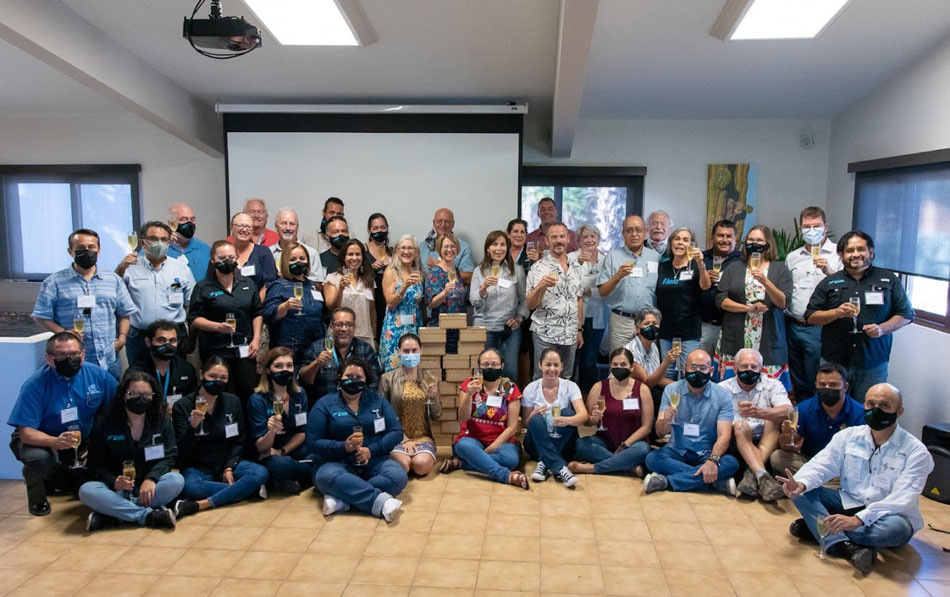
CEMA’s mission is “… to promote, facilitate, and make accessible the generation, dissemination and transfer of high-level scientific and technological knowledge, to create capacities, make decisions and increase the development of communities of the region. A hub where researchers, students, and institutions from Mexico and around the world interact with local stakeholders to combine their skills to help reverse ecosystem deterioration and mitigate environmental changes.” The center will strengthen the link between scientific knowledge and local influence on long-term socio-economic system preservation, and will promote improved livelihoods through science-driven educational and developmental actions. By providing facilities, equipment, and logistical assistance, CEMA will promote the region as a natural laboratory for advancing understanding and value of the resources.
“As a long-time supporter of Eco-Alianza, it’s very exciting to dream about elevating scientific discovery to this level. With CEMA, who knows what we will learn about Loreto and its coasts and seas? CEMA will be a source of pride for the community for many years to come.”
–Anne McEnany, Alumbra Innovations, Senior Program Officer
Day One of the Summit focused on “Context Analysis.” Objectives for the day included identifying barriers and obstacles that researchers and their institutions face in the field, elements that facilitate fieldwork in a research project, and defining the role of a field station. Dr. Omar López Cruz, Researcher at the National Institute of Astrophysics, Optics and Electronics, opened the conversation with an inspiring presentation, “Science and Society: Is there a Link?” He explored historical references related to research and posed questions such as, “What do black holes have to do with security?” Dr. Miguel Angel Ojeda Ruiz de la Peña from UABCS, cited an example of San Antonio, BCS, where scientific collaboration and field work made possible to achieve a diverse economy based on sustainable practices. M.S. Everardo Mariano, Director of the Vizcaino Biosphere Reserve of the National Commission for Natural Protected Areas (CONANP), and M.S. Felipe Neri Melo from the Interdisciplinary Marine Science Center (CICIMAR-IPN) discussed collaborative research models.

Dr. Omar López Cruz
Conversations sparked during the day continued into the evening, as participants and guests gathered at Rancho El Jaral for a catered dinner. Tony and Linda Kinninger welcomed the guests, and Fr. Tom Elewaut, Pastor, Mission Basilica San Buenaventura blessed the evening meal. Jon Rebman, Ph.D., Curator of Botany, San Diego Natural History Museum, the evening’s key note speaker, shared a slide show and discussion of plant species in Baja. He highlighted those that are endangered, along with several newly discovered species, endemic to the region, which emphasized the untapped treasures of Baja.
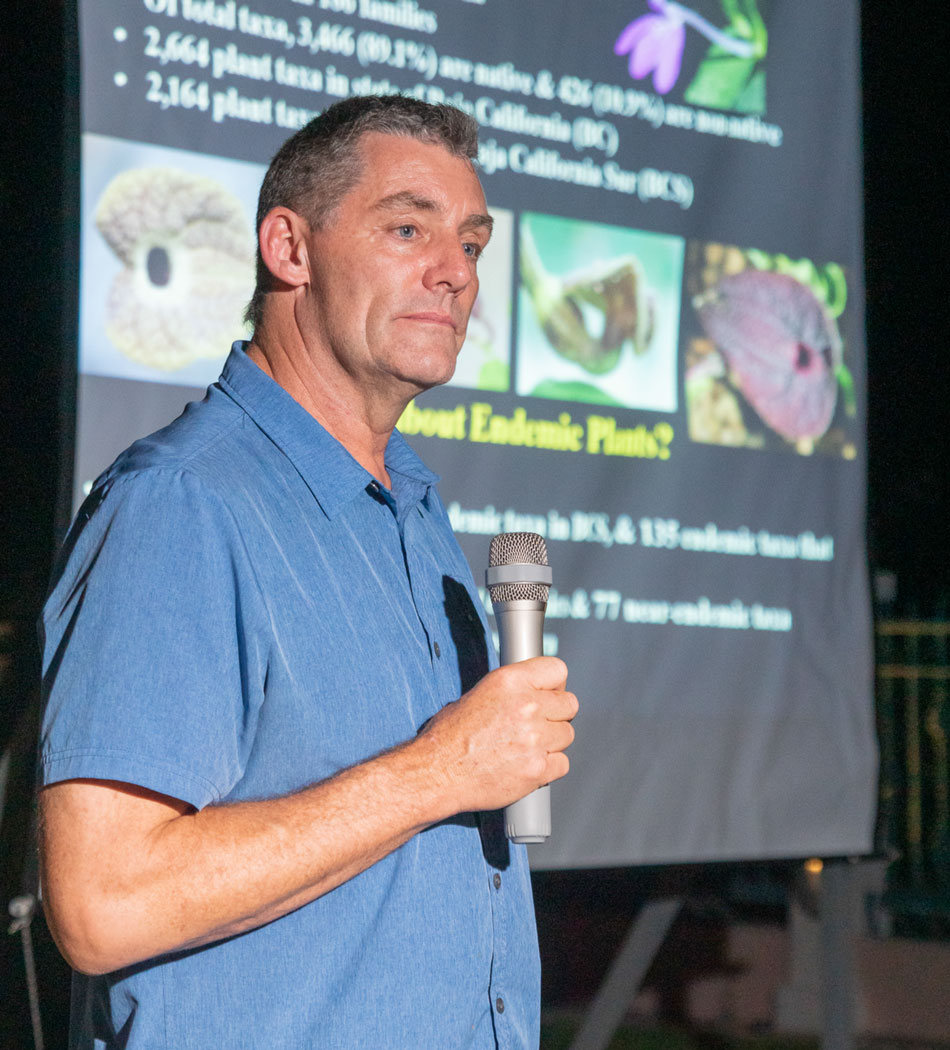
Jon Rebman
Day Two of the Summit focused on “The Design of the Field Station Model.” Objectives included: Defining the role of a field station for successful research, looking at various models of field stations at other sites, defining the benefits of a field station such as CEMA, and building models of operations for a field station to satisfy the needs of the attendees.
Ing. Hugo Quintero, CEO/Executive President, Eco-Alianza de Loreto, welcomed everyone and provided a quick recap of what had transpired the previous day. He shared CEMA objective, mission, vision and justification statements. Linda Kinninger presented conceptual designs, both renderings and floor plans, for a proposed physical plant, a two-story 9,221 square foot building on property adjacent to CenCoMA, ½ block from the Sea of Cortez. As planned, the building will provide meeting rooms, a conference center and living space for visiting researchers and their students. The roof top will support a native plant garden with seating areas, as well as solar panels to offset power usage. The adaptable floor plan includes the possibility for various lab and field equipment spaces.
Nicolas Pinter, Ph.D., UC Davis, Dr. Miguel Ángel Ojeda Ruiz del la Peña, UABCS, and and Dr. Silverio Lopez Lopez, CICIMAR-IPN explored the role of field stations in research and their various models. Dr. Pinter shared slides of his students on field trips in the Channel Islands National Park, the Grand Canyon and Loreto. A professor and researcher of Geology, Nicolas spoke to the immeasurable value of putting students into biggest lab of all – the wilderness – so that they can experience first-hand, the workings of earth forces upon the landscape. Dr. Lopez highlighted the significance of collaboration, as one of the keys for successful scientific investigation. Dr. Ojeda Ruiz de la Peñaspoke about the UABCS’ contribution to regional scientific knowledge, as well as how a field station can help the university fulfill its research goals and train researchers, as well as the university’s experiences with using a field station to develop scientific research and student training.
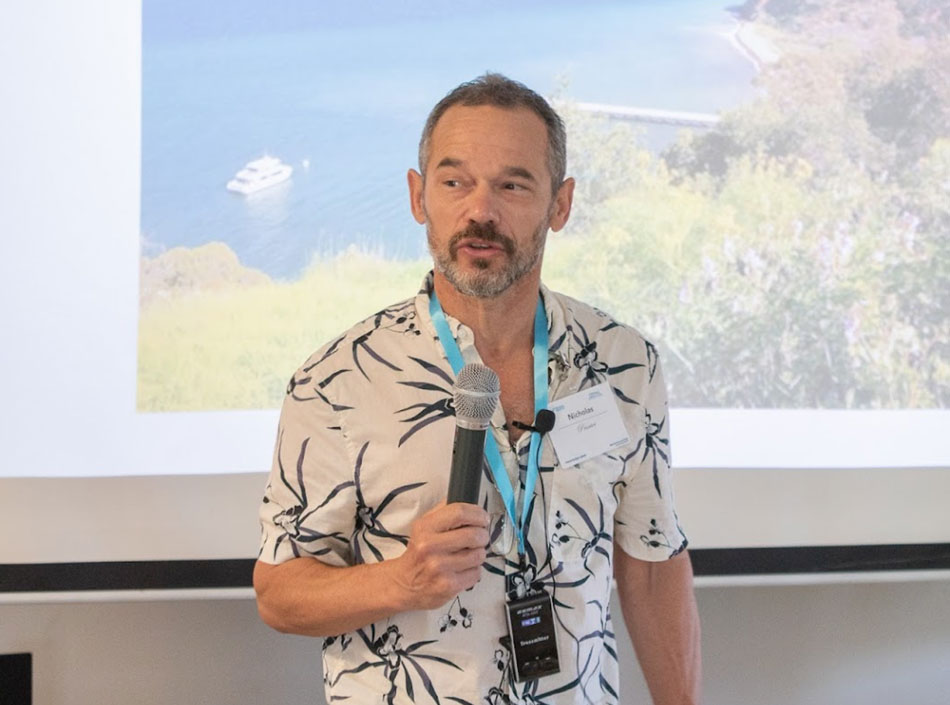
Nicolas Pinter
Suzanne Olyarnik, Ph.D., Director of Bodega Bay Marine Reserve, discussed the value of the Natural Reserve System of the University of California, and the role of field stations. She explained that within the UCNRS, stations vary greatly in form and purpose, provide scientific information to help solve real world problems, and offer local communities a wealth of opportunities. She shared slides of students in the field, including the Bodega Marine Laboratory. She concluded with a list of factors of why Loreto is an ideal location for a field station:
- Incredible natural areas for study and exploration across many disciplines
- Collaboration with UABCS, CICIMAR, other Mexican universities
- Jumping off point for the Parque Nacional Bahia de Loreto
- Access to a broad range of ecosystems
- Local economy to support and facilitate research & classes
- Eco-Alianza’s network of partners
- Building cross-border science and research partnerships
- Cross-cultural exchange opportunities for students
- Elevating the intrinsic value of the region’s natural areas
- Elevating the intrinsic value of science
- … and many more.

Suzanne Olyarnik
Russell Galipeau, Superintendent (Ret.), Channel Islands National Park, U.S. Park Service followed with a presentation about Santa Rosa Island Research Station. The station was established in 2012, to promote and support research and education across all academic levels with an inquiry-rich learning experience. The goal: to develop and expand knowledge and critical thinking skills to promote education and learning, and promote science literacy and resource stewardship. He encouraged the utilization of an interdisciplinary approach that incorporates the arts, such dance, ceramics, and painting.
“The Summit was a fabulous springboard for the CEMA initiative – the event brought together the key stakeholders, helped us to focus the vision for CEMA, and energized all of us to bring this vision towards becoming a reality.”
–Nicholas Pinter, PhD, Associate Director, Center for Watershed Sciences at the University of California Davis.

Russell Galipeau
Afternoon break-out sessions challenged small groups of participants to reach into the future and describe CEMA at the end of the coming year. The exercise focused on translating the Summit presentations into actionable items in areas such as marketing, funding, research projects, community outreach, university participation, and physical facilities. The summations of these sessions were presented to the re-gathered group.
Chris McHone, Chief, Political & Economic Section, U.S. Consul General Tijuana, and Anne McEnany, Senior Program Officer, Alumbra Innovations, provided closing remarks. Chris spoke to the value of CEMA to the region, and the economic and intellectual growth, both invaluable in promoting the growth of B.C.S. Anne, the former President of the International Community Foundation had long been a supporter of Eco-Alianza, and had championed our efforts to protect Baja’s marine and terrestrial wilderness areas. She said, “I have watched Eco-Alianza grow into a professional organization with a very important blend of Mexican and international leadership and financial support. This organization is thriving and clearly, it’s thinking big!”
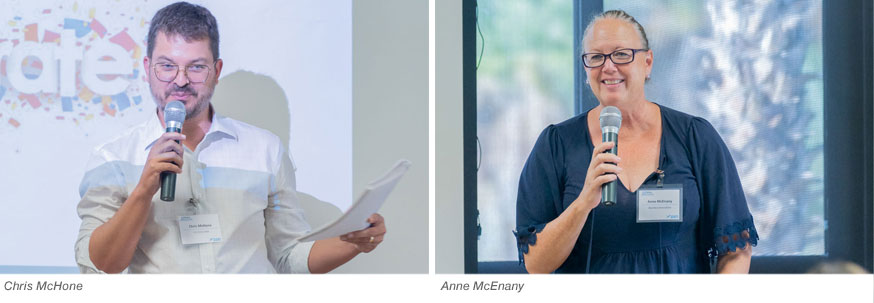
As a final activity of the day, each participant was gifted a small wooden box. Inside each box was a sheet of yellow paper, with blanks for a participant’s name and their commit in support of CEMA for the next year. Symbolically, each box was placed on a growing stack on the floor as the commitments were read aloud to the group, setting into motion, the foundations of the research center.
“It was so uplifting and inspiring to be part of the brainstorming process that will guide the development of the new interdisciplinary field station of CEMA. Undoubtedly it will significantly further conservation science on the peninsula, and put the results directly into the hands of the communities where that information is needed most”
–Sula Vanderplank, Director of the Pronatura Northwest Conservation Program

Day Three was spent touring the shoreline of Isla Coronado on the “Wild Swan,” as guests of the Kinninger’s. Lunch was served on the beach, along with presentations from M.C. Israel Popooca, PNBL-CONANP, M.C. Everardo Mariano, ReBiVi-CONANP, about the challenges facing both the Loreto Bay Marine Park and the El Vizcaino Biosphere Reserve along with a discussion of their wealth of resources. Ph.D. John Rebman, San Diego Natural History Museum, and Veronica Zamora, CIDIIR Durango – IPN, provided guided tours of the area adjacent to the beach, identifying plant species and discussing their value to the habitat, including a visit to a local bat cave.
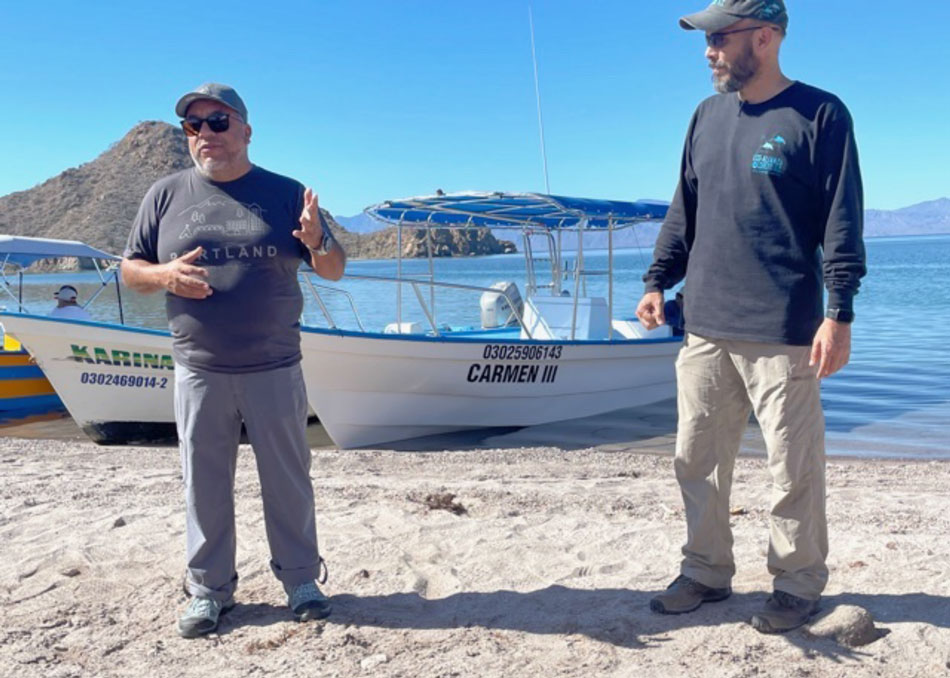
M.C. Everardo Mariano
Loreto Mayor, La Presidenta, M.C. Paola Cota Davis, spoke during the luncheon. She expressed her gratitude for all the contributions that Eco-Alianza has made to the city of Loreto, and her support and excitement for the future of CEMA.
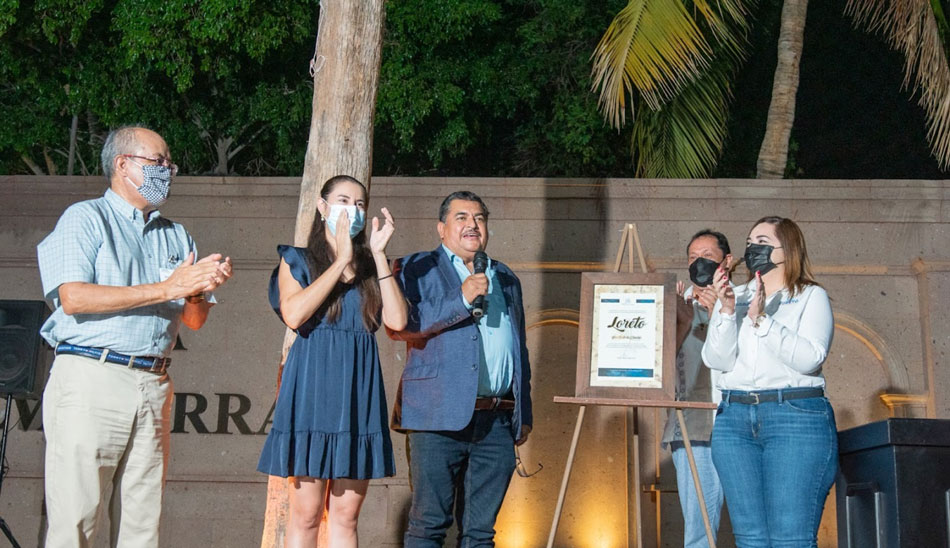
M.C. Paola Cota Davis, municipal president, and Dr. Omar Lopez unveiling the name “Loreto Puerto de la Ciencia” during the closing ceremonies at Plaza Salvatierra of the CEMA International SUMMIT
“The international summit to discuss and plan for the new CEMA was exciting and productive! It was great to interact with so many different people from Mexico, hear more about how the Loreto field station can support and facilitate their work, and to work through how CEMA can address some of the challenges to doing field work in the region.”
–Suzanne Olyarnik, Ph.D., Reserve Director, Bodega Marine Reserve
A farewell breakfast closed the CEMA Summit on Sunday morning. Presentations and group session proposals are being collating for inclusion in an on-line database, staff is busy establishing mileposts and guidelines for follow-up, and planning a second international summit for 2022.
www.ecoalianzaloreto.org/about-cema/






